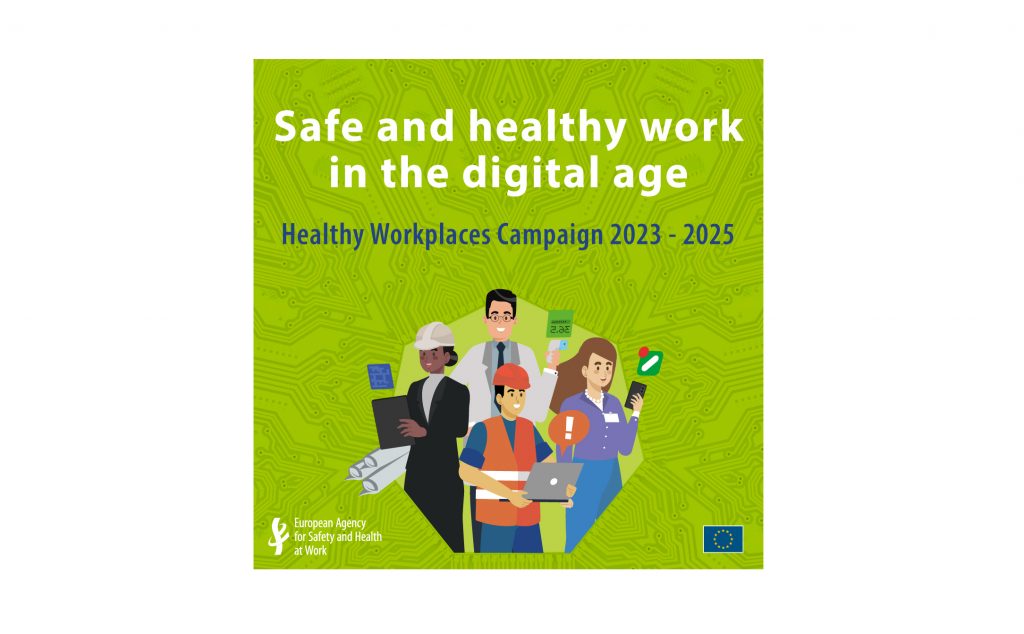Future magazine interviews Dr Dietmar Elsler, Senior Research Project Manager, EU-OSHA, about the agency’s important work in promoting safe, healthy workplaces across Europe
The European Agency for Safety and Health at Work, otherwise known as EU-OSHA, is one of the European Union (EU) agencies and serves a fundamental purpose for all member states. Based in Bilbao, Spain, its mission is to develop, gather and provide reliable and relevant information, analysis, and tools to advance knowledge, raise awareness and exchange occupational safety and health (OSH) information and good practice which will serve the needs of those involved in OSH.
EU-OSHA’s work also contributes to the European Commission’s Strategic Framework on Health and Safety at Work (2021-2027) and other relevant EU strategies and programs. It strives to be a recognized leader promoting healthy and safe workplaces in Europe based on tripartism, participation and the development of an OSH risk prevention culture, to ensure a smart, sustainable, productive, and inclusive economy.
Watch the video interview with EU-OSHA’s Dr Dietmar Elsler below
The price of poor health and safety
“We have still 175,000 people dying from work-related causes [each year], from diseases or from accidents,” says Elsler. “Half of them are dying from cancer. Only 2% of these people actually die in an accident nowadays. So, the EU member states were very successful in reducing accidents, but the challenge is diseases like cancer, cardiovascular diseases, musculoskeletal diseases, or psychosocial diseases, which cause us a huge economic burden.”
EU-OSHA estimates that 3.3% of the EU GDP, around 550 billion euros, is lost each year through accidents and diseases caused by work. On top of the economic cost, the human cost of 175,000 people taken out of the workforce each year can have significant knock-on effect amongst member states, where a shortage of skilled workers and an aging population have already created major employment issues.
“We have still 175,000 people dying from work-related causes each year, from diseases or from accidents. Half of them are dying from cancer. Only 2% of these people actually die in an accident nowadays”
Dr Dietmar Elsler, EU-OSHA
The Healthy Workplaces Campaigns are vital to EU-OSHA’s efforts to raise awareness of occupational safety and health throughout Europe. The message of these campaigns is clear — ‘Safety and health at work is everyone’s concern. It’s good for you. It’s good for business.’
The campaigns are the largest of their kind in the world and each has a clearly defined theme — previous campaign topics range from promoting risk assessment and prevention to raising awareness of sustainable working and protecting workers from dangerous substances. The most recent campaign ‘Safe and healthy work in the digital age 2023-25’ focuses on the impact digitalization can have on employees.
Advancing faster than any innovation in our history, digital technologies have transformed our society and our daily lives. For workers and employers in many workplaces and in all sectors, digital technology offers increased opportunities but also presents greater challenges and risks in terms of safety and health.
According to EU-OSHA’s 2019 ESENER survey, the vast majority of companies in the EU have integrated digital technologies in their operations, with only 6% of companies reporting to use none of them. But despite the increasing use of robots, laptops, smartphones or wearable devices, less than one in four workplaces (24%) in the EU are having discussions about the potential impact of such technologies on the safety and health of workers.
Aimed to raise awareness, provide practical resources and bring stakeholders together, the 2023-25 Healthy Workplaces campaign is in line with the European Commission’s Vision Zero approach to promote a prevention culture. It also draws on research conducted by EU-OSHA for the OSH Overview on Digitalization 2020-2023.

Data-driven research
Aside from these campaigns, the EU-OSHA website is host to a wealth of facts and figures. The EU-OSHA OSH-Barometer is a unique data visualization tool where EU countries can compare their situation in workplace health and safety with those of other member states. EU-OSHA also supports its work through surveys, including the European Survey of Enterprise on New and Emerging Risks (ESENER), which interviews 45,000 workers across 33 European countries. It provides a valuable tool for related European policymaking, it examines how health and safety risks are identified and managed, and with a view to improving this, explores possible drivers and barriers, with an in-depth look at legislation.
Also important is how EU-OSHA supports the European Commission’s Strategic Framework on Health and Safety at Work (2021-2027). The Strategy has adopted a ‘Vision Zero’ approach, whereby it strives to eliminate work-related deaths within the EU; EU-OSHA’s data and campaigns are therefore extremely important in furthering this goal.
Promotion through partnerships
EU-OSHA’s responsibilities are not small, but the agency is run by a mere 65 workers. Therefore, EU-OSHA relies a lot on its tripartite network structure and national Focal Points, and it is important that its campaigns are in addition supported by about 100 Official Campaign Partners, such as the long-term partner Sofidel. The Official Campaign Partnership offer is open to European and international companies and organizations that are ready to join a network of leading public and private organizations, inspiring and encouraging others to successfully manage a safe and healthy workforce.
“These partnerships are of mutual benefit because we provide campaign material in all the European languages, so if you are a multinational company, you can roll out the campaign in your different plants and different countries in the different languages,” explains Elsler. “We offer you opportunities to exchange good practices, to take part in our events, and to promote the campaign on our website.”
“Sofidel is really acting as a multiplier, as a model in their region and industry for the supply chain,” says Elsler. “If Sofidel sets a good example, they will also influence their supply chain and deal responsibly with their supply chain, in health and safety.”
“We provide campaign material in all the European languages, so if you are a multinational company, you can roll out the campaign in your different plants and different countries in the different languages”
Dr Dietmar Elsler, EU-OSHA

Elsler recalls a meeting at a Sofidel production site near Lucca in 2017, where Sofidel, as their campaign partner, organized a tour of their factory and exhibited their safety management practices to other company partners. “We really are very grateful to show that this support is possible,” says Elsler.
Looking ahead to the future, EU-OSHA has its campaign on the digital workplace to run and will further analyze its Workers’ exposure survey on cancer risk factors in Europe (WES), which first results have just been published. The survey aims to better identify the cancer risk factors responsible for most of the exposures, providing an accurate and comprehensive overview that can contribute to preventive measures, awareness-raising, and policymaking, ultimately helping in the fight against occupational cancer. The first results of WES identified solar ultraviolet (UV) radiation, diesel engine exhaust emissions, benzene, respirable crystalline silica (RCS) and formaldehyde as the most frequent probable occupational exposures among the 24 cancer risk factors analyzed.
Climate change is also high on EU-OSHA’s agenda, and specifically linked to the EU Green Deal. Elsler highlights the significant impacts of climate change on human health and safety at work. From extreme weather conditions to higher ambient temperatures, the effects of climate change are far-reaching and varied. For example, the effect of heat stress on outdoor laborers in construction and agriculture, as well as office workers, is to be examined, whether through overexposure to the sun or sleep deprivation as a result of overly high temperatures.
“We want also to come back to a more classical topic like accident prevention in the next few years,” says Elsler. “The EU was very successful in reducing numbers, but now we have a kind of plateau effect in many countries, the curve is not going down anymore. It’s stabilizing on a relatively low level, but we have still 3,300 people dying each year, and in addition many work-related traffic accidents (e.g. during commuting).”
To achieve ‘Vision Zero’, Elsler says the EU needs ‘more efforts, and more research’. For this, EU-OSHA’s work will continue to be indispensable.
Further details:
For more information visit osha.europa.eu







